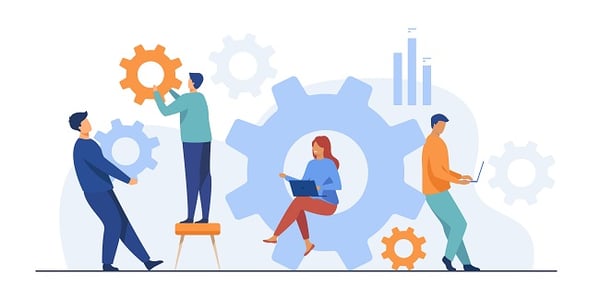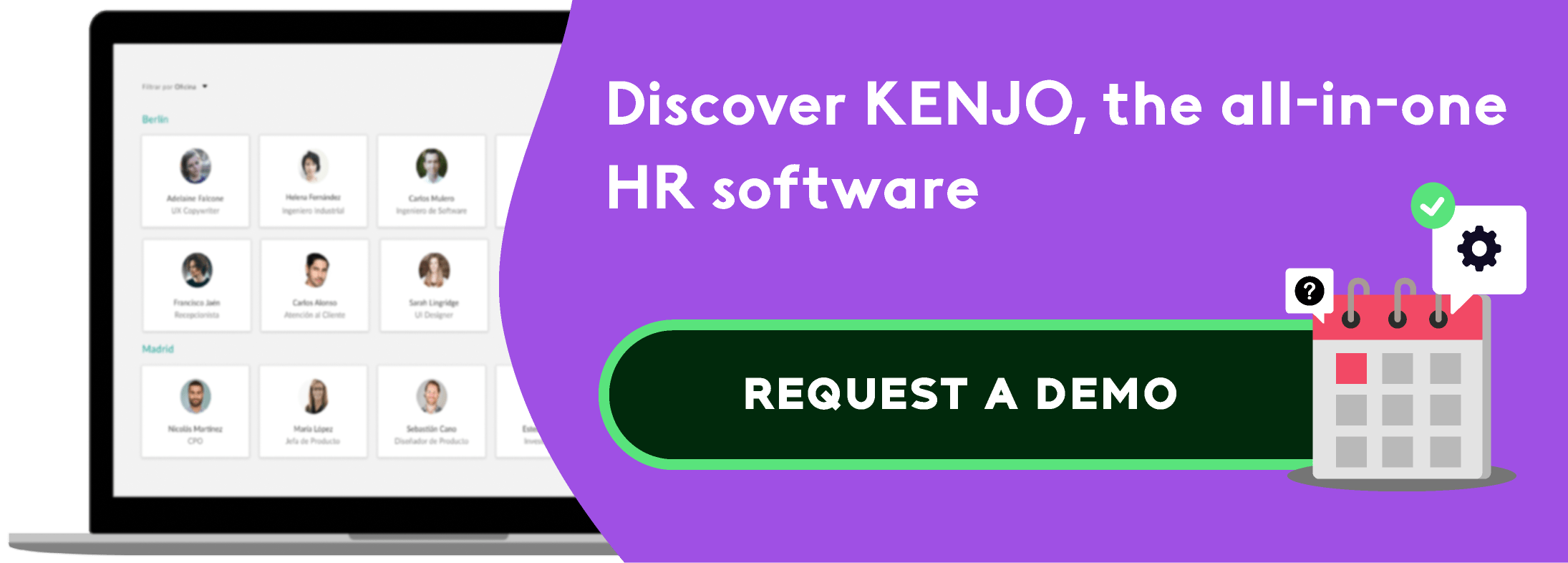Main functions of a human resources department

The functions of a human resources Department are numerous and diverse, as this team is responsible for managing a company's human capital to meet the established business objectives. The personnel department is key in any company, from attracting and retaining talent to guaranteeing the interests and well-being of employees.
Forbes magazine mentions a number of studies that show the importance of aligning human resources strategies to reach business objectives and improve business performance. Studies acknowledged that it is possible to achieve a real competitive advantage through people, and the companies that do achieve excellent results.
What are the objectives of a HR department?
To understand the functions of the personnel department, it's important to know what to expect of it and what objectives it has. Generally speaking, we know that its primary task is to contribute to a company’s success by finding, maintaining and developing human capital. On one hand, this is achieved through the creation of efficient programmes and, on the other, ensuring that they comply with established rules and procedures in this area.
More specifically, the main objectives of the HR department are:
1. Contribute to the company’s business objectives
Achieving company objectives requires a competent team of human talent. The CEO or board of directors has to establish the organisation's needs and the human resources team has to find the right people to meet them, both in and outside the organisation.
2. Attract and retain the best talent
The human resources team must attract and retain the best professionals in the sector. This requires a carefully planned strategy as well as activating the necessary programmes to stimulate workforce motivation and well-being.
3. Improve employees’ quality of life
The human resources department must be committed to guaranteeing the employees’ well-being, motivation and development within the company. Measuring the working environment, activating development programmes and offering incentives are just some examples of the work they do.
4. Improve productivity
On an internal level, the personnel department also has to supervise the productivity and performance of the entire team. They will hopefully be able to detect opportunities for improvement and activate plans to implement.
5. Ensure compliance with regulations
There are numerous employment regulations and laws for which the HR department will always be ultimately responsible. Holidays, sick leave, maternity/paternity leave... all of this is regulated and must be rigorously enforced.
What does the human resource department do?
Fernando Arias G., author of Administración de Recursos Humanos (Human Resources Administration), defined people management as “the discipline that looks after the organisation of employees that work in a company, in order to meet the objectives of both parties.” As this definition and the above mentioned points suggest, this department’s role is fundamental.
Not only does it look after the needs and situations that arise with the people of an organisation, it is also in charge of ensuring a good work climate and fostering the well-being and productivity of the workforce.
It is also where members of the organisation go to seek help, advice or support. The people working in this department must therefore be in touch with the working environment and understand the particularities of the company, every employee, the current economic situation and the labour market.
What are the functions of a HR department?
The list of tasks is therefore virtually endless, so we could say that HR functions are numerous and extremely varied. All these functions must be clear when creating the human resources department and design a strategic plan. Let's look at them individually.
1. Personnel administration
The administrative management of staff is one of the central tasks in the personnel department This includes the management of contracts, payslips, authorisations, sick leave, annual leave, absences due to maternity/paternity, etc.
This is purely administrative work which is time-consuming and requires a good level of team coordination with the whole team, employees and the authorities to avoid errors and problems in the future.
Many human resources departments use Excel spreadsheets to carry out these tasks. These days, however, human resources management software enables you to automate much of this work and gain time savings of 40%.
2. Personnel recruitment and selection
Another main function of the HR department is attracting and selecting the best talent.
Firstly, the team has to work on their employer branding so that the most sought-after professionals in the sector become interested in working for the company. Google, for example, has become one of the most coveted companies in the world due to its excellent reputation as an employer.
A LinkedIn study showed that 75% of professionals who are actively looking for work assess a company's image before applying for a job position. And 96% of employers believe their reputation positively affects their revenue.
Once professionals have applied for a post, the next step is to launch a selection process to interview, identify and select the most suitably qualified candidates and that have the greatest potential. A recruitment software organises this process, improves the candidate experience and offers reports and analyses in just one click.
3. Compensation and incentive management
Human resources are also responsible for workers salaries and benefits. This includes the calculation of an appropriate pay rates for every position, taking into account the value they bring to the company, the salary offered in the labour market and the parameters set by the collective agreement.
This task also includes regular employee salary reviews, negotiating incentives with suppliers, such as restaurant tickets and medical insurance, setting objectives and offering performance-based benefits.
Guaranteeing and fulfilling employee salary expectations is an important part of this task, to foster staff motivation and well-being within the company.
4. Development of a positive work climate
The work climate is one of the most important factors in the company as it significantly influences workers’ well-being and productivity. Experts agree that a positive work climate:
- Increases productivity.
- Reduces absenteeism.
- Increases motivation
- Strengthens commitment.
How can the human resources team assess if the company has a positive work climate? Workplace climate surveys are the most popular tools because they help to gather valuable information about employee satisfaction, enabling the company to detect problems and improve decision-making. They can be automated and sent by email, making it easier for employees to respond.
Fostering a positive work climate is very simple. Space, for example, has a significant influence. Different studies have detected that an open office design increases productivity by 20% and natural light brings an increase of 40%.
In addition, the work climate was one of the most highly valued aspects by 22% of employees in Best Workplaces.
5. Employee performance evaluation
Evaluating employee performance is another human resource management activity. Each employee’s performance and their commitment to the company should be regularly assessed. Specific and measurable objectives for every member of the organisation and a pre-established evaluation system are essential for this process.
This is usually done with the use of employee performance appraisal software. Using a cloud-based platform offers the possibility for several people to appraise an employee, which in turn allows more information to be gathered. This enables human resources to make both a qualitative and quantitative performance assessment.
6. Staff training and development
The personnel department should also implement training schemes to ensure the growth of every employee in the company and the development of key skills for the company's future. Not only is this a way to attract and retain talent, but also of maximising the potential of your human capital. Organising courses, training, establishing career paths and internal promotion are key tasks for human resources.
Ideally, the department should outline a strategy that includes:
- The current and future needs of the company.
- A differentiated training plan for each job role.
- A plan of implementation through classes, conferences workshops...
7. Labour relations
Human resources are also responsible for addressing labour problems and negotiating with trade union representatives (where they exist). This entails:
- Mediate between employers and employees.
- Mediate between employees in the event of an internal conflict.
- Negotiate employee rights with trade unions or interested parties.
- Act as company or employee representatives when necessary.
Ultimately, the department should address any conflict related to the company, recruitment, wage policies, etc.
8. Occupational health and safety
HR plays a vital role in the creation and implementation of occupational health and safety policies. This can be a particularly delicate task in many sectors as we are dealing with health and safety of employees. The team must:
- Implement safety measures when regulations change.
- Ensure compliance with regulations
- Negotiate safety measures with trade unions and employees.
Job roles in the field of human resources
To carry out all these activities, there are a series of indispensable job roles required in a human resources department.
- Director of human resources or HR officer: this person is responsible for the department and their role is to develop and implement strategies that help the company reach its objectives through human talent.
- Recruitment specialist: the person responsible for recruitment and carrying out the selection process. Their role is therefore crucial when the company needs to hire new talent.
- Training and development specialist: if a company is committed to staff training and development, then it should have a person dedicated to overseeing it. This profession analyses the team's needs and develops specific programmes with clear-cut objectives.
-
Labour relations and payroll specialist: this role oversees the administration of payroll, annual leave, contracts, renewals, etc., with the aid of specific software to help them work faster and more efficiently.
- Occupational health and safety specialist: when a company carries out an activity that poses a higher risk for employees (such as construction, for example), it's vital to have an occupational health & safety expert to guarantee workforce safety.
- ITC specialist: considering how important IT systems have become for human resources management, an expert in these systems is a vital asset to the department. Their main job is to ensure the proper use of available tools.
- Internal communications specialist: while this role is not yet commonplace, an internal communications specialist plays a key role in developing communication policies within the company. The result is a more loyal and committed workforce.

Simplify your human resources management with Kenjo
A human resources department’s job isn’t easy, so it’s crucial to use technological tools to facilitate this work. The Kenjo human resources software has been designed to automate processes and save 40% of the time spent on administrative tasks.
The latest Deloitte Human Capital Trends Report “the degrees of success obtained from the implementation of cloud-based technologies has helped organisations consolidate data, creating a single user interface and improving access to data.”
With our software, you can dedicate more time to what’s really important: people. Try it and see for yourself.


